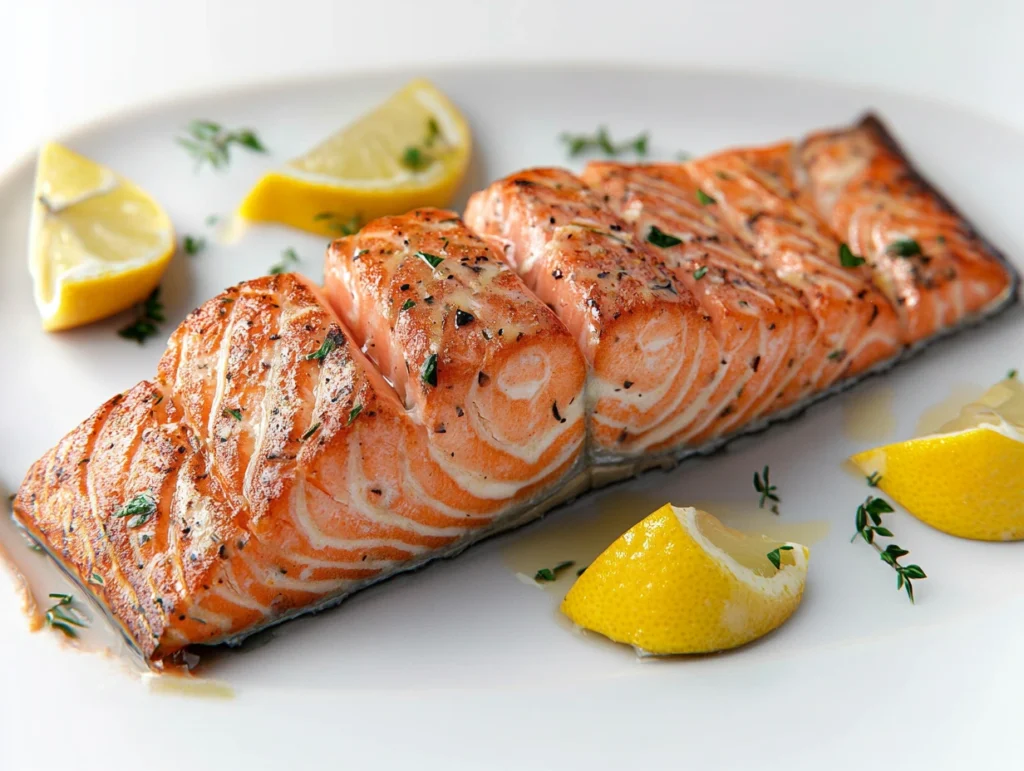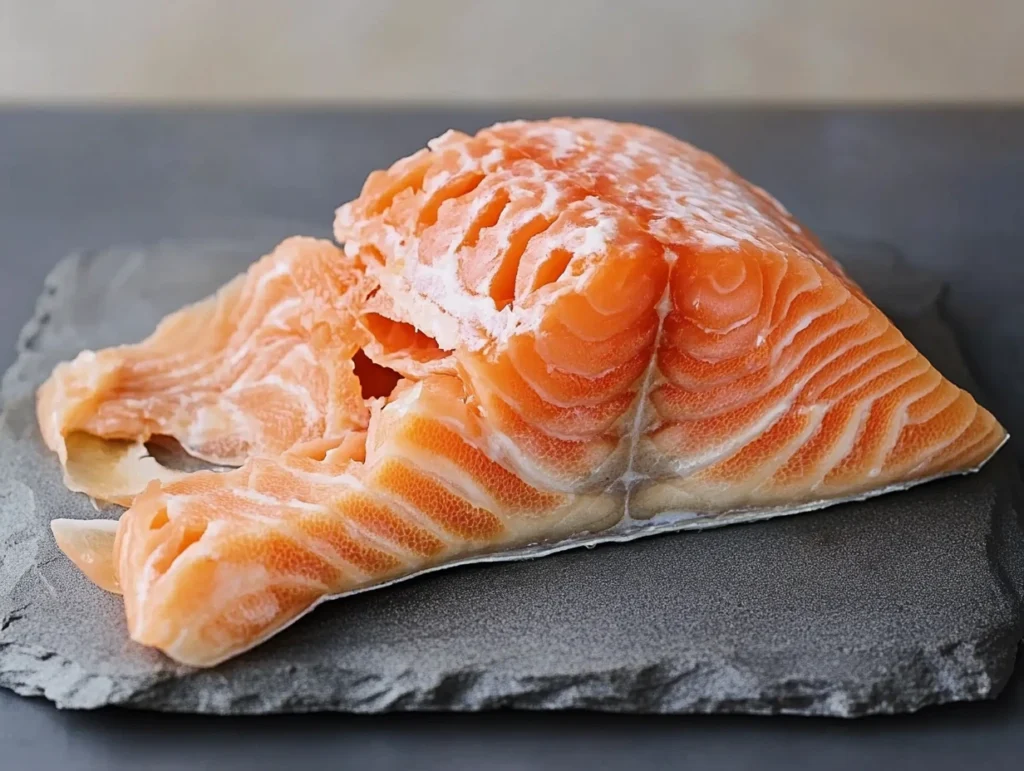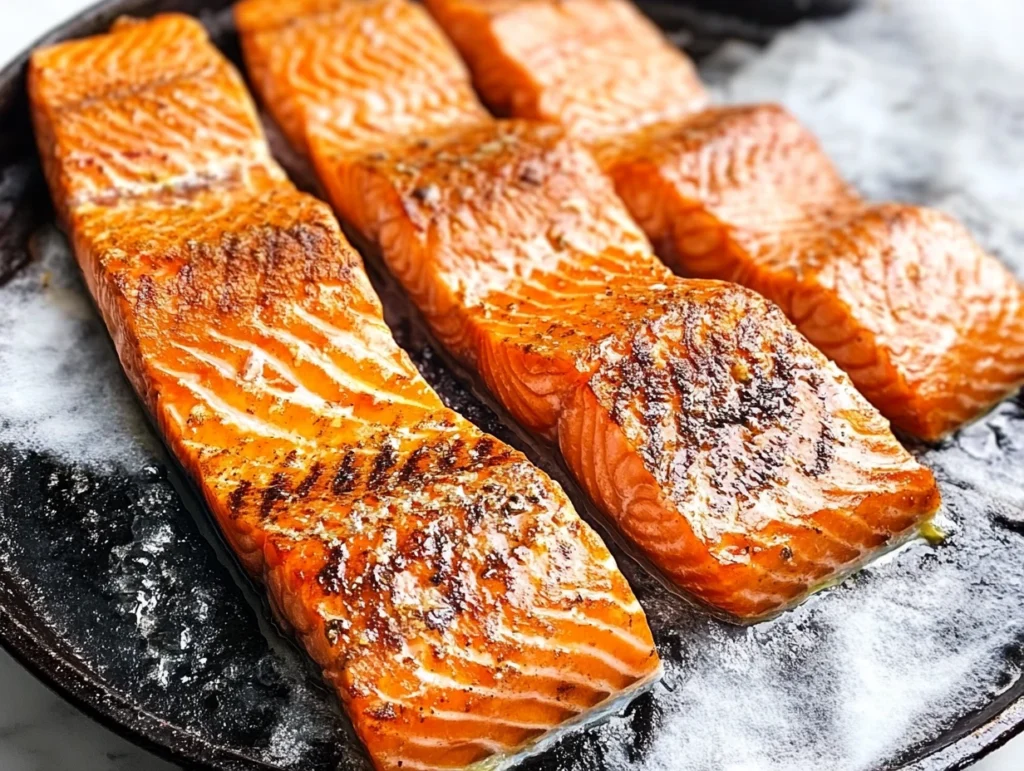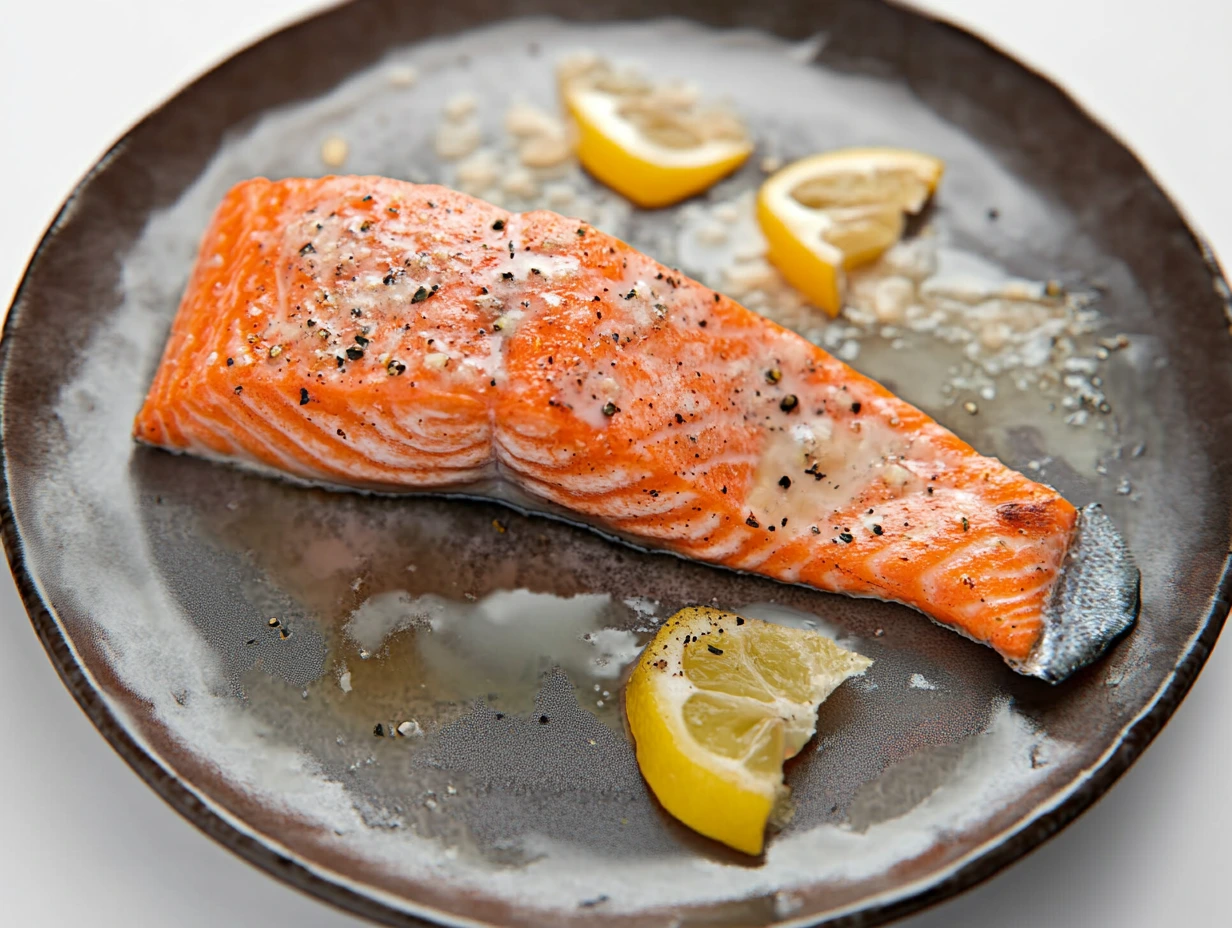Table of Contents
Grilling salmon be cold before grilling is a delicate art that requires a balance of technique and precision. Among the many variables, the temperature of the salmon—both before and during cooking—plays a crucial role in achieving perfectly cooked fish. Understanding how temperature affects the texture, flavor, and safety of grilled salmon (Should salmon be cold before grilling) can elevate your grilling skills to a new level.

Why Does Salmon Temperature Matter Before Grilling?
Temperature is a critical factor in cooking salmon because it directly impacts how evenly the fish cooks. Salmon is prone to overcooking, which can make it dry and tough. Starting with salmon at the wrong temperature can lead to uneven cooking, where the exterior is done while the center remains undercooked—or worse, overcooked while attempting to fix the issue. The temperature also influences how well the fish retains its moisture, ensuring a tender and flavorful result.
Ideal Temperature for Grilling Salmon
Room Temperature or Cold?
The preparation temperature of salmon before grilling is a topic of debate. Many chefs recommend allowing the salmon to rest at room temperature for about 15–30 minutes before grilling. This approach ensures that the fish cooks more evenly, as cold salmon straight from the refrigerator can take longer to heat through, increasing the risk of an overcooked exterior and undercooked center.
However, it’s crucial not to leave salmon at room temperature for too long. Fish is highly perishable and should not remain unrefrigerated for more than two hours (or one hour if the ambient temperature is above 90°F/32°C) to avoid bacterial growth.
Internal Temperature Goals
Achieving the perfect internal temperature is essential for salmon that is moist, flavorful, and safe to eat. The USDA recommends cooking salmon to an internal temperature of 145°F (63°C), measured at the thickest part of the fish. However, some chefs and food enthusiasts prefer slightly lower temperatures for a more tender and moist texture:
- Medium-Rare: 120–125°F (49–52°C)
- Medium: 130–135°F (54–57°C)
- Well-Done: 140–145°F (60–63°C)
Using a meat thermometer ensures precision, helping you avoid overcooking or undercooking. Additionally, allowing the salmon to rest for a few minutes after grilling allows the heat to redistribute, reaching the final desired temperature.
Steps to Prepare Salmon for Grilling
Grilling salmon begins with proper preparation, ensuring the fish cooks evenly and achieves optimal flavor and texture. Here’s a step-by-step guide to preparing salmon for the grill:
1. Thawing Frozen Salmon
If you’re starting with frozen salmon, proper thawing is essential for even cooking. Here are the recommended methods:
- Refrigerator Thawing: Place the frozen salmon in its original packaging or a sealed container on a plate to catch any drips. Let it thaw in the refrigerator for 8–12 hours, depending on the thickness of the fillet. This method is the safest as it keeps the fish at a constant, safe temperature.
- Cold Water Thawing: For a quicker method, place the salmon in a sealed plastic bag and submerge it in cold water. Change the water every 30 minutes to maintain a safe temperature. Most fillets will thaw within 1–2 hours.
- Avoid Room Temperature Thawing: Never leave salmon to thaw at room temperature, as this can encourage bacterial growth.
2. Drying and Seasoning
Once thawed (or if using fresh salmon), proper surface preparation is key to achieving a good sear and preventing the fish from sticking to the grill.
- Dry the Surface: Use a paper towel to pat the salmon fillets dry. Removing excess moisture helps the fish develop a better crust and prevents steam buildup during cooking.
- Season Generously: Lightly brush the salmon with olive oil or melted butter to enhance flavor and prevent sticking. Season with salt, pepper, and any additional spices or marinades to suit your taste. Popular seasonings include garlic, dill, lemon zest, paprika, or a blend of herbs. Let the seasoning rest for a few minutes to penetrate the fish.
3. Bringing to Room Temperature
Allowing the salmon to rest at room temperature before grilling is an important step for even cooking.
- Why It’s Important: Cold salmon placed directly on the grill can cause the exterior to overcook while the interior remains undercooked. Bringing the fish closer to room temperature ensures a more even heat distribution.
- How to Do It: After thawing and seasoning, let the salmon sit at room temperature for 15–30 minutes, depending on the fillet’s thickness. Avoid exceeding this time to reduce the risk of bacterial growth.
Tips for Perfect Grilled Salmon
Grilling salmon can seem challenging, but with the right techniques and preparation, it’s easy to achieve perfectly cooked, flavorful results. Here are some essential tips to help you master grilling salmon.
1. Preventing Stickiness
Salmon is prone to sticking to the grill, which can ruin its appearance and make cleanup difficult. Use these techniques to prevent sticking:
- Preheat the Grill: Always preheat your grill to medium-high heat (around 375–400°F or 190–204°C) before adding the salmon. A hot grill minimizes sticking by searing the fish upon contact.
- Oil the Grill Grates: Use a paper towel dipped in a high-heat oil (such as canola or avocado oil) and carefully rub it onto the grill grates using tongs. This creates a non-stick surface.
- Use Skin-On Fillets: Leaving the skin on provides a natural barrier, helping the flesh hold together and preventing sticking. You can remove the skin after grilling if desired.
- Avoid Overhandling: Once the salmon is on the grill, let it cook undisturbed for 4–6 minutes (depending on thickness) before flipping. It will naturally release when it’s ready to be turned.
2. Using Marinades and Rubs
Enhancing the flavor of salmon with marinades and rubs can elevate your grilling game. Here’s how to make the most of them:
- Marinades: A marinade adds flavor and can help tenderize the fish. Use a blend of oil, acid (such as lemon juice, vinegar, or soy sauce), and seasonings like garlic, ginger, or herbs. Limit marinating time to 15–30 minutes to prevent the acid from breaking down the delicate flesh.
- Dry Rubs: For a more concentrated flavor, use a dry rub made of spices and herbs. Popular combinations include paprika, cumin, brown sugar, chili powder, and dried dill. Apply the rub evenly and let the salmon sit for 5–10 minutes before grilling.
- Avoid Excess Marinade or Rubs: Too much marinade or a thick rub layer can burn on the grill. Lightly pat the salmon with a paper towel to remove excess before cooking.
3. Choosing the Right Grill
The type of grill you use can influence the outcome of your grilled salmon. Consider the following options:
- Gas Grills: Gas grills are ideal for precise temperature control, making them beginner-friendly. Preheat the grill, and maintain consistent heat to avoid flare-ups that can char the salmon.
- Charcoal Grills: For a smoky flavor, use a charcoal grill. Arrange the coals for direct and indirect heat zones, giving you flexibility to sear the fish and finish cooking gently. Adding wood chips can enhance the smoky aroma.
- Electric Grills: Electric grills are convenient for indoor or small-space grilling. While they don’t impart a smoky flavor, they provide consistent heat and are easy to use.
- Use Grill Accessories: For any type of grill, consider using a fish basket or aluminum foil to make handling the salmon easier, especially for delicate or skinless fillets.

Common Mistakes When Grilling Salmon
Grilling salmon can be a rewarding experience, but even minor missteps can affect the final outcome. Here are some common mistakes to avoid, along with tips to ensure perfectly grilled salmon every time.
1. Cooking While Too Cold
Grilling salmon straight from the refrigerator is a common mistake that can lead to uneven cooking.
- The Issue: Cold salmon takes longer to cook, which often results in an overcooked exterior while the interior remains undercooked. Additionally, the sudden temperature shock from fridge to grill can cause the fish to stick or lose its natural texture.
- The Fix: Allow the salmon to rest at room temperature for 15–30 minutes before grilling. This helps the fish cook more evenly and reduces the risk of sticking. However, don’t leave the fish out for too long to prevent bacterial growth.
2. Overcooking or Undercooking
Striking the perfect balance between fully cooked and overdone salmon can be tricky.
- The Issue: Overcooked salmon becomes dry and tough, while undercooked salmon can be unsafe to eat or have an unpleasant texture.
- The Fix: Use a meat thermometer to monitor the internal temperature. Aim for:
- Medium-Rare: 120–125°F (49–52°C)
- Medium: 130–135°F (54–57°C)
- Well-Done: 140–145°F (60–63°C) Start checking the temperature a few minutes before the estimated cooking time ends. Additionally, remember that salmon continues to cook slightly after being removed from the grill, so factor in carryover cooking.
3. Ignoring Grill Prep
Failing to prepare the grill properly is a common oversight that can lead to sticking or uneven cooking.
- The Issue: A dirty or improperly oiled grill can cause the salmon to stick, tear, or cook unevenly. Additionally, grilling on a surface that isn’t hot enough prevents the fish from achieving a good sear.
- The Fix:
- Clean the Grill: Always start with clean grill grates. Residual food particles from previous grilling sessions can cause sticking.
- Preheat the Grill: Ensure the grill is preheated to medium-high heat (375–400°F or 190–204°C). A hot grill sears the fish quickly, creating a natural non-stick barrier.
- Oil the Grates: Use a paper towel dipped in a high-heat oil, such as canola or avocado oil, and rub it onto the grates with tongs. This creates a non-stick surface that minimizes tearing.

FAQs: Grilling Salmon
Here are answers to some of the most frequently asked questions about grilling salmon to help you master the art of cooking this delicious fish.
1. How Long Should I Grill Salmon?
The cooking time depends on the thickness of the salmon fillet. As a general guideline:
- Grill salmon for 8–12 minutes total, flipping halfway through.
- Cook 4–6 minutes per side for a 1-inch-thick fillet.
Always check for doneness using a meat thermometer or by observing the texture; the fish should flake easily with a fork.
2. What Temperature Should Salmon Be Cooked To?
For the best results, use these internal temperature guidelines:
- Medium-Rare: 120–125°F (49–52°C)
- Medium: 130–135°F (54–57°C)
- Well-Done: 140–145°F (60–63°C)
Remove the salmon from the grill a few degrees before it reaches your target temperature, as it will continue to cook off the grill.
3. Should I Leave the Skin On?
Yes, it’s generally a good idea to leave the skin on when grilling. The skin acts as a protective barrier, helping to keep the salmon moist and prevent sticking to the grill. You can remove the skin after cooking if desired.
4. Can I Grill Salmon Without Foil?
Yes, you can grill salmon directly on the grates. To prevent sticking:
- Preheat the grill to medium-high heat.
- Oil the grates thoroughly with a high-heat oil.
- Let the salmon cook undisturbed for 4–6 minutes on one side before flipping.
If you’re concerned about sticking, you can use a fish basket or grill the salmon on a piece of foil with holes poked in it for ventilation.
5. What’s the Best Way to Season Salmon for Grilling?
Salmon pairs well with a variety of flavors. Popular options include:
- Simple seasoning with salt, pepper, and olive oil.
- Marinades with citrus (lemon or orange), garlic, soy sauce, or honey.
- Dry rubs with paprika, cumin, dill, or brown sugar for added depth.
Apply your seasoning or marinade before grilling and allow it to rest for 15–30 minutes for the best flavor absorption.
6. Should I Use Direct or Indirect Heat?
Both methods can be effective, depending on your goal:
- Direct Heat: Ideal for searing and quick cooking. Use medium-high heat and flip the salmon halfway through.
- Indirect Heat: Best for thicker fillets or when grilling salmon with a glaze. Start the salmon on the indirect heat side of the grill, then finish with direct heat for a nice crust.
7. Can I Grill Frozen Salmon?
It’s best to thaw salmon before grilling for even cooking. If you must grill it frozen:
- Rinse off any ice glaze.
- Increase the cooking time by about 50%.
- Use indirect heat to ensure the interior cooks thoroughly without burning the exterior.
8. How Do I Know When Salmon Is Done?
Salmon is done when:
- It reaches your desired internal temperature (see Question 2).
- The flesh becomes opaque and flakes easily with a fork.
- It feels firm but not hard when pressed gently.
9. Can I Grill Skinless Salmon?
Yes, but it requires extra care to prevent sticking or falling apart. Use a fish basket or aluminum foil, and oil the fish thoroughly before placing it on the grill.
10. What’s the Best Type of Salmon for Grilling?
Both wild-caught and farmed salmon can be grilled successfully, but they differ in flavor and fat content:
- Wild Salmon: Leaner with a stronger flavor, such as sockeye or coho.
- Farmed Salmon: Higher fat content, resulting in a milder flavor and a more forgiving texture on the grill.
When preparing salmon for grilling, ensuring it’s not too cold is crucial for even cooking and achieving a perfect texture. For those looking to complement their grilled salmon, consider pairing it with a grilled salmon salad for a refreshing meal. If you’re using marinades, you might find inspiration from recipes like slow cooker shrimp recipes, which offer bold flavors that can be adapted to grilled dishes. Additionally, understanding seasoning options, such as those discussed in the fish taco seasoning recipe, can help enhance your grilled salmon with vibrant and complementary flavors.
Conclusion
Grilling salmon is both an art and a science, with temperature playing a pivotal role in the outcome. From ensuring the fish is at the right temperature before grilling to achieving the perfect internal doneness, every step contributes to a moist, flavorful, and evenly cooked result. Avoiding common mistakes, like cooking salmon straight from the fridge or neglecting grill preparation, can transform your grilling experience.
By following these tips and techniques, and leveraging complementary recipes and seasoning ideas, you can master the process and consistently create delicious grilled salmon that’s sure to impress. Whether you’re a seasoned chef or a home cook, the key to success lies in understanding the nuances of temperature, preparation, and flavor. Enjoy your perfectly grilled salmon!

